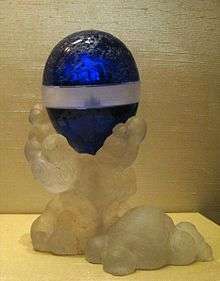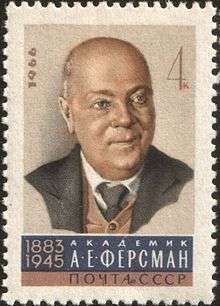Fersman Mineralogical Museum
Fersman Mineralogical Museum (Russian: Минералогический музей им. А. Е. Ферсмана) is one of the largest mineral museums of the world, located in Moscow, Russia. Its collections include more than 135,000 items. Among them natural crystals, geodes, druses and other kinds of mineral treasures. The museum was named after Alexander Fersman.
.jpg)
History
Early history
The museum was founded in 1716 in Saint Petersburg as a mineral cabinet of Kunstkamera. As a base for this mineral cabinet a collection of 1195 specimens was bought by Gotvald, a doctor of medicine from Danzig, at the behest of Tsar Peter the Great. This collection was enriched by the material from Russian deposits and opened for public view in 1719.
During the reign of Peter the Great mineral collections grew very quickly. They were replenished with specimens which were presented to members of the imperial court or to the tsar personally. For example, in 1718 Charles XII of Sweden presented to Peter a magnificent example of natural, crystallized "rope" of silver from the royal silver mines at Kongsberg in Norway. This 21 cm long specimen called "Silver Horn" is the oldest specimen in the collections of the Russian Academy of Sciences.
In 1745 the collection included more than 3000 minerals, fossils, gems and rocks. By this time it was already one of the most enviable Europe collections with a great aesthetic and scientific value. This great quantity of material required sorting and cataloging. The first to be appointed to the task of organizing the mineral cabinet was a German scientist Johann Gmelin (1709-1755). Thereafter, Mikhail Lomonosov, who had just completed his studies in Germany, continued his work. For almost five years, Lomonosov sorted out the collection and compiled a catalogue which was published in 1745.
On 5 December 1747 a great fire destroyed virtually the whole collection. Only the most valuable items were saved, including the "Silver Horn". In 1836 the Kunstkamera was divided into 7 separate museums, including Mineralogical museum which was moved to the new building. In 1898 the museum was significantly expanded and renamed the Geological museum.
In 1912, the name was changed to the Museum of Geology and Mineralogy, dedicated to Peter the Great. The mineral research laboratory was founded and research trips were organized to the Urals, Siberia and Transbaikalia.
In Moscow
Museum was moved from Petersburg to Moscow in 1934 together with the Russian Academy of Sciences. Thirty railway carriages were required to move the museum's collection of more than 60,000 specimens. The relocation and setting up of the exhibition took three years of energetic work. In 1936 and 1937 the museum organized independent exhibitions in Moscow.
Collections

All museum acquisitions since 1716 were divided at the beginning of 20th century by the academician Vladimir Vernadsky to 5 main collections:
- Systematic collection consists of more than 90000 items representing about 2400 mineral species (from 4000 species known in nature). Mineral specimens in this collection demonstrating diversity of mineral species by it constitution, morphology, physical properties, associations with other minerals.
- Crystal collection includes more than 4800 crystals of minerals representing all crystal systems and most of space groups. Mineral specimens in this collection demonstrating different forms and their combinations, twinning laws, perfection and defection of natural and man made crystals.
- Locality collections included more than 31000 specimens representing genetic features, mineral association and ore types for more than 300 former Soviet Union deposits and couple dozen well known localities in other countries.
- Pseudomorph collection includes about 2200 mineral specimens, representing different kinds pseudomorphs and also different features of mineral growing and transformations in various conditions.
- Gems and stone art collection includes аmong 8000 rough and faceted gemstones, items made of stones. A large part of this section is Russian stone art from the eighteenth to twentieth centuries including some thirty items designed by Peter Carl Fabergé, including the last Fabergé egg, the Constellation egg.
Directors

- 1835-1845 Grigori Gelmersen
- 1845-1857 Konstantin Grevingk
- 1857-1866 Adolf Gebel
- 1866-1873 Nikolai Koksharov
- 1873-1900 Fyodor Shmidt
- 1900-1906 Feodosy Chernyshov
- 1906-1919 Vladimir Vernadsky
- 1919-1945 Alexander Fersman
- 1930-1945 Vladimir Kryzhanovsky (executive director)
- 1945-1945 Vladimir Kryzhanovsky
- 1947-1953 Dmitri Belyankin
- 1953-1976 Georgi Barsanov
- 1976-1980 Yuri Orlov
- 1980-1982 Vladimir Sobolev
- 1983-1995 Aleksandr Godovikov
- 1995-present Margarita Novgorodova
External links
| Wikimedia Commons has media related to Fersman Mineralogical Museum. |
- Photo (1024x768)
- (Russian) (English) Fersman Mineralogical Museum home page
- (Russian) Article in the GeoWikipedia
Coordinates: 55°43′7″N 37°35′34″E / 55.71861°N 37.59278°E